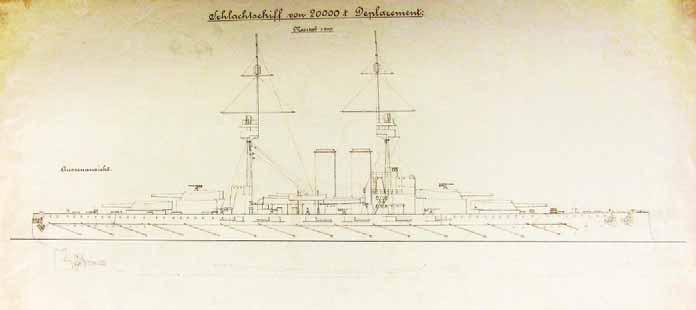In a draft agreement made in April 1914, 283.13 million Kronen was the share of the Austrian and 135.71 million Kronen (two battleships, six destroyers and two monitors) the share of the Hungarian industry.417 This meant only 32.4 % instead of 36.4 % of the orders for Hungary. Because a written formal agreement is missing from the files of the Kriegsarchiv, it is not known what the Navy exactly presented to the Hungarian negotiating party led by Finance Minister Teleszky. Doubtlessly, it should have been satisfactory for the Hungarians because on 20 May the Hungarian delegation voted in favor of the credit without any debate. On 28 May the Austrian delegation voted in favor of the credit as well, but only after a brief debate. The Austrian Social Democrat Karl Leuthner lamented that still more big, expensive battleships would be launched “into the ocean of the Austrian state debt.”418 The Fate of the “Improved Tegetthoff ” Class As was mentioned previously, on 1 July 1914 the Navy approved the final design of the “Improved Tegetthoff ” class. Unfortunately, there are a few unanswered questions about the fate of these battleships. The first problem is that in the files of the Kriegsarchiv in Vienna there is no sign of an official contract with either of the two shipyards.419 Only the ten plus one spare 35 cm guns were ordered from the Škoda works.420 In the spring of 1914, the Navy made the following building schedule for the battleships VIII-XI:421 VIII August 1914 – July 1917 IX August 1914 – August 1917 X January 1916 – January 1919 XI January 1916 – January 1919 However, in March 1914 the II Geschäftsgruppe questioned if the detailed plans of the 24,500 ton battleship would be completed in time.422 This may mean that the schedule above was too optimistic. Whatever the Navy actually ordered one or more battleships or not, some preparatory works continued after the outbreak of the war. On 5 August, the joints of the barbette armor were tested by firing a 30.5 cm projectile on them,423 but probably nothing significant happened after this test. It is almost completely certain that neither of the first two battleships was laid down, because the average time in
Austria-Hungary between the order and the laying down of the keel of a battleship was 6 to 8 months and the battleships were cancelled a little more than four months after the outbreak of the war. Allegedly the Hungarian Finance Ministry tried to achieve the cancellation of the construction of the 24,500 ton battleships in October 1914. In December 1914, the 24,500 ton battleships were cancelled unofficially by the Navy,424 the official cancellation occurred at the 3 February 1915 meeting of the common Council of Ministers. Formally the battleships were not cancelled but their construction was postponed until the end of the war. From the eleven 35 cm guns ordered two were certainly finished and a third may have been finished.425 The first gun, the Rohr Nr. 1 (Barrel No. 1) was tested at Pilsen in November 1914. These guns were designated as 35 cm M16 and were used on the Italian Front and on the Romanian Front. On the latter front a 35 cm gun along with two 42 cm howitzers provided artillery support for the Mackensen-Army which crossed the Danube at Shvistov in November 1916. The Rohr Nr. 1 after firing 122 rounds was sent back from the Italian Front to the Škoda where it was found that despite its damaged chamber the gun was still serviceable.426 The ultimate fate of these guns after the war is unknown. Little more than half a year after the cancellation of the 24,500 ton battleships, the Navy began to work on new battleship and battlecruiser designs. The MTK presented a series of battlecruiser proposals of 30,000 – 32,000 tons armed with 9×35 cm, 6×38 cm or 4×42 cm guns. In addition, two battleship proposals were made between 1915 and 1917, a 30,000 ton ship armed with 8×38 cm guns and a 37,000 ton ship armed with 8×42 cm guns.427 These plans were completely unfeasible, in fact the Navy could not build ships larger than destroyers of 800 tons during the war, and the budget of the Navy declined after 1914. In sharp contrast to the ambitious battleship and battlecruiser proposals of the MTK, the sad reality was that the Navy had to keep in commission the tiny and obsolete coastal defense ships of the Monarch class which would have been replaced by the new battleships. Finally, some remarks on the ship’s names: there is a popular belief that the first 24,500 ton battleship to be laid down in the STT yard was to be named Laudon, while her sister which would have laid down in the Ganz and Co. Danubius was to
— 118 —






























